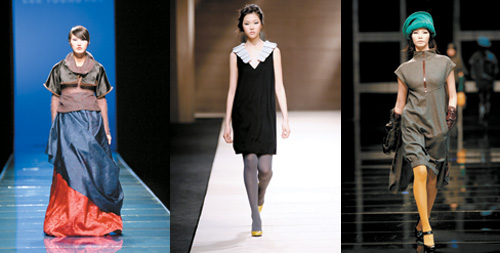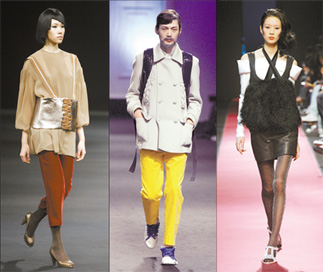An industry in search of its identity

Lee Young-hee, Rubina, Andy & Debb
This year the annual budget for the semi-annual Seoul Collections is 1.8 billion won ($1.6 million), a 500 million won increase over last year. Hahn Seong-hee, the director general of the Seoul Fashion Center, said the money was mostly spent inviting buyers and journalists from around the world. A total of 750 guests received free return flights and accommodation, but was there anything for them to see?
Bursting with pride, Hahn said that the Seoul Collections recorded $4.5 million worth of garment sales last year. However, when he says that a Korean-made garment is hot it’s not likely to be a couture gown of the sort worn by Kate Moss. It’s more likely to be a tacky T-shirt marketed as a bulk item to shopping malls in Russia or China. Pricey items bearing the labels of well-known Korean designers are hard to sell overseas.
“Because of the current low market value of Korean designers, it is important that designers, who may have an extremely good reputation in Korea, sell at prices that meet the demands of overseas markets,” Hahn said. “Korea’s top designers like Park Choon-moo did well last year and I believe she’s learned how to do well in the international market.”
Hahn added that about 60 percent of the invited buyers at last week’s shows were wholesale merchants from Russia, the Middle East and the United States.
But fashion isn’t just a numbers game, and seasoned fashion journalists who globe-trot between the major international collections are the toughest to impress.
Francois Guenet, a veteran TV journalist from Montreal, Canada, was left underwhelmed by Seoul’s offerings.
Guenet said he was disappointed with the presentation of the styles and selection of designers. “Many designers seem to be showing work designed for showrooms, not for runways, and they need to be careful with details and styling,” he said. “We want to see more traditional Korean influences in the clothes, like [Japanese designer] Kenzo did years ago. Korean designers should learn from their own past and make it modern.”
Melinda Trina, a producer for French television networks, said she found most of the clothes shown on the runways were copies from magazines. “I’m worried about what I’m going to present [from the Korean fashion shows] back in France,” she said.
Both journalists agreed that the Seoul Collections are not ready to invite important international fashion critics, who would be much harsher with their comments.
Hahn’s response was that comparing the Seoul Collections, which are just turning seven years of age, with major international collections is not fair. He stressed that Korean fashion needs to be nurtured like other industries, such as technology, which developed in Korea to become a global power -house in less than two decades.
Perhaps it is this “think big and fast” management style of Korean business leaders that drove the Seoul collections to become more like an industrial machine than a source of creativity.
Many internationally acclaimed fashion houses that have become dominant forces on the global stage, had small beginnings, but with strong chief designers, concrete concepts and clear visions they were able to grow upon a solid foundation of creativity, talent and a passion for fashion. They have become especially adept at producing great fashion shows.

Jinteok, Bon, Ro Sungun Provided by Modanews
When the Seoul Collections began in October 2000, supported by the government, they were a humble gathering of 12 young designers who wanted to work on the global stage. There was no foreign press. Although the quality of the productions, and the politics involved with a government-backed fashion collection, were heavily criticized by established designers, the event seemed to promise a future for Korean fashion. It’s not clear that the event’s goals have been realized.
From 2000 onward, the theme for the collections has been “the bigger, the better.” As a way to build a force to be reckoned with, the government and organizers lobbied fashion industry moguls in an attempt to unify all the privately held fashion shows in Korea.
When it showcased 60 designers over 10 days in the fall of 2004, the collections attracted over 70,000 spectators, a big jump from 12,000 in 2000. But growth in the collections did not translate into a solid foundation for the industry, nor did the quality of the catwalk productions improve that much.
Since the Seoul Collections have to set their schedule in the gaps between major collections in Paris or New York in order to attract major buyers and the press, the shows don’t coincide with the local fashion cycle. Thus the majority of spectators are students from local design colleges who got free tickets from their professors.
That the Seoul Collections have previously received hardly any coverage from the foreign press doesn’t help inspire weather-worn designers either.
Most of the older designers, who amassed a fortune during the period when Korea’s fashion market was closed to foreign designers, are not interested in venturing into international markets or investing in the next generation of designers.
Over the years Korean culture has also played a crucial role in the retardation of Korea’s fashion industry. Outside the fashion-crazy venues, the general public doesn’t care or doesn’t want to be bothered with who wears what and when, which explains why many Koreans ignore any dress codes set for social functions. This distaste for fashion comes from attitudes that have deep roots.
In Korea, the idea of being fashionable was associated with vanity and has, on occasion, been viewed as a social evil.
New currents of consumerism in the late 1980s changed many aspects of Korean society. Gone are the housewives protesting against “bad” imported products in front of the newly built Hyundai Department Store; instead the daughters of these housewives have become indispensable members of Korea’s luxury market and they don’t mind paying top dollar for a limited edition Louis Vuitton bag.
In this environment, with no systematic support, frustrated but ambitious designers who nurtured dreams of becoming the next Giorgio Armani have grown increasingly skeptical about the role of the Seoul Collections. An event that had promised to be a launching pad for their international careers has, for them, failed to take off.
For designers who create highly polished suits for the rich and fabulous, nothing is more disenchanting than to see droves of Chinese merchants looking for cheap copies. That is precisely why fans of the celebrated designer Jung Wook-jun will not find his name in the collections’ timetable this year he has decided to show his work in Paris instead.
“I’ve been skeptical about being part of it [the Seoul Collections],” he said on the phone from Paris. “It now includes local apparel companies that use the collections as an opportunity to promote their showroom brands.” Preparing for his June debut, Jung, arguably one of the most talented tailors to emerge from the Korean branch of L’Ecole Superieure des Arts et techniques de la Mode, said that going overseas was the only way for him to become a truly international designer.
Is there any hope for Korean fashion? Hahn, who was formerly a fashion designer and studied fashion at New York’s Fashion Institute of Technology in the 1980s, is certainly aware of the problems, but he remains optimistic.
“Just look at how far Korea has come since 1950, when the entire country had absolutely nothing,” he said. “We once wore our own clothing, hanbok, but we quickly adopted Western culture, and there is nowhere else in the world that has built an infrastructure as fast as Korea. If Westerners had to create a fashion industry out of the Korean hanbok, the way we now have to do with Western clothing, they would be lost for a long time, just like we are now.”
His confidence in Korean fashion, he says, comes from the global success of Korean brands such as Samsung and LG. “We Koreans once thought Samsung would be forever B-class and no one imagined it would surpass Sony and Nokia, but it did.”
After a pause he mentioned Steve J and Yoni P, Doori Jung and Woo Young-mi, all Korean-born fashion designers who have recently made names for themselves in London, New York and Paris, respectively.
“At the moment, these talented Korean designers are doing their own thing in their own places. I’m sure that when Korean fashion gets big enough to bring all these designers together, we might be able to conquer the world. It might never happen, but then again, when there is enough motivation it could happen in a second. We just don’t know exactly when.”
By Ines cho Staff Writer [inescho@joongang.co.kr]










with the Korea JoongAng Daily
To write comments, please log in to one of the accounts.
Standards Board Policy (0/250자)